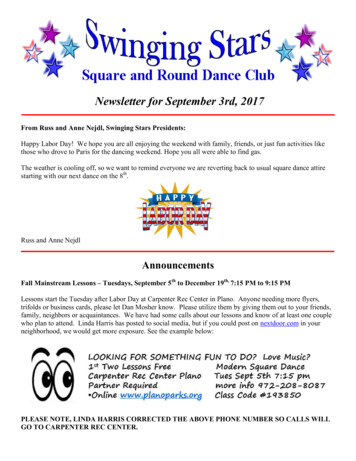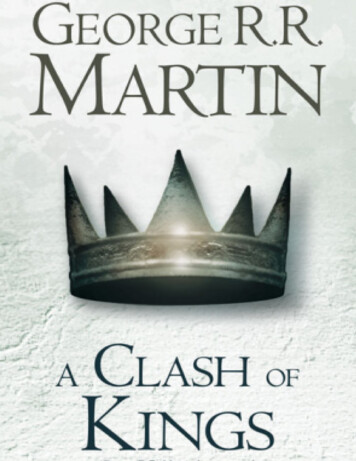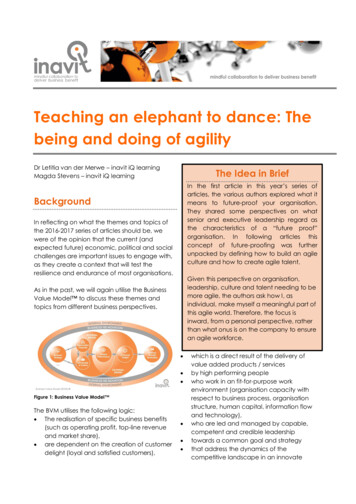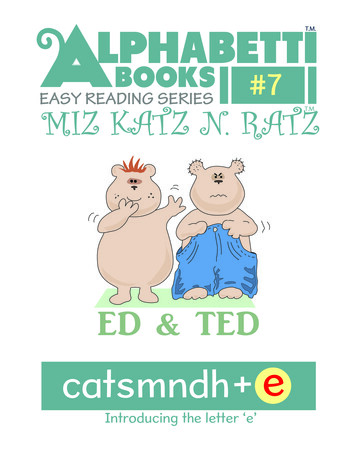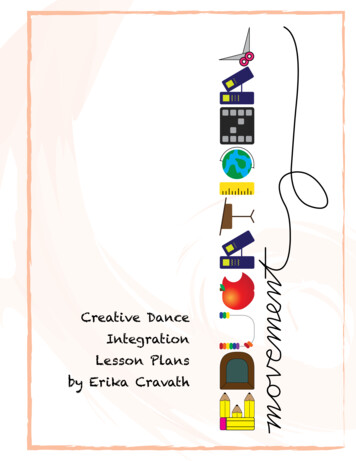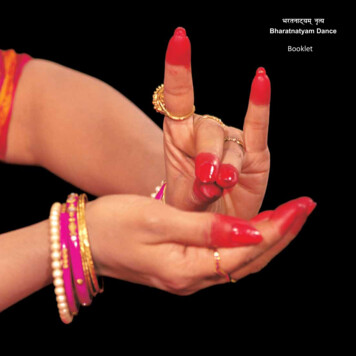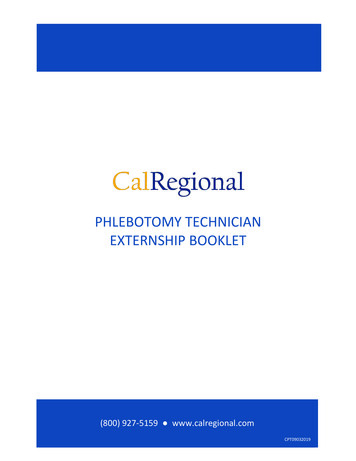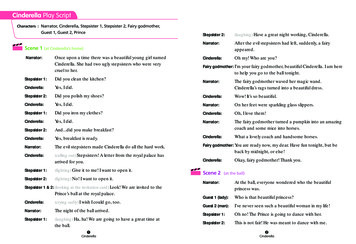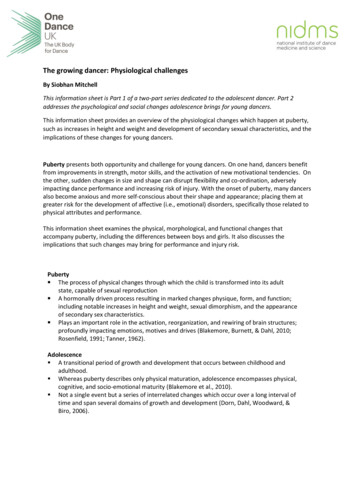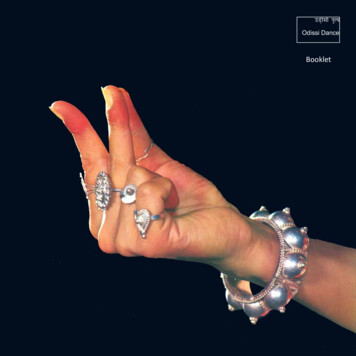
Transcription
mM hlh u R;Odissi DanceBooklet
Hkkjr esa u R; cgqr izkphu dky ls ,d le ¼ vkSj izkphu ijEijk jgk gSAfofHkUu dkyksa dh [kqnkbZ] f'kykys[kksa] ,sfrgkfld o.kZu] jktkvksa dh oa'k&ijEijkrFkk dykdkjksa] lkfgfR;d L kksrksa] ewfrZdyk vkSj fp kdyk ls O;kid izek.kmiyC/ gksrs gSaA ikSjkf.kd dFkk,a vkSj nardFkk,a Hkh bl fopkj dk leFkZudjrh gSa fd Hkkjrh; turk osQ /eZ rFkk lekt esa u R; us ,d egRoiw.kZLFkku cuk;k FkkA tcfd vkt izpfyr 'kkL kh;* :iksa ;k dyk* osQ :i esaifjfpr fofo/ u R;ksa osQ fodkl vkSj fuf'pr bfrgkl dks lhekafdr djukvklku ugha gSaAlkfgR; esa igyk lanHkZ osnksa ls feyrk gS] tgka u R; o laxhr dk mn xe gSA u R;dk ,d T;knk la;ksftr bfrgkl egkdkO;ksa] vusd iqjk.k] dfoRo lkfgR; rFkkukVdksa dk le ¼ dks"k] tks laLo Qr esa dkO; vkSj ukVd osQ :i esa tkus tkrsgSa] ls iqufuZfeZr fd;k tk ldrk gSA 'kkL kh; laLo Qr ukVd (Mªkek) dk fodkl,d of.kZr fodkl gS] tks eq[kfjr 'kCn] eqnzkvksa vkSj vko Qfr] ,sfrgkfld o.kZu]laxhr rFkk 'kSyhxr xfrfof/ dk ,d lfEeJ.k gSA ;gka 12oha lnh ls 19ohalnh rd vusd izknsf'kd :i gSa] ftUgsa laxhrkRed [ksy ;k laxhr&ukVd dgktkrk gSA laxhrkRed [ksyksa esa ls orZeku 'kkL kh; u R;&:iksa dk mn; gqvkA[kqnkbZ ls nks ewfrZ;ka izdk'k esa vkbZ&,d eksgutksnM ks dky dh dkals dh ewfrZvkSj nwljk gM Iik dky (2500&1500 bZlk iwoZ) dk ,d VwVk gqvk /M A ;gnksuksa u R; eqnzkvksa dh lwpd gSaA ckn esa uVjkt vko Qfr osQ vxznwr osQ :i esabls igpkuk x;k] ftls vke rkSj ij u R; djrs gq, f'ko osQ :i esa igpkuktkrk gSA gesa Hkjreqfu dk ukV ;&'kkL k 'kkL kh; u R; ij izkphu xzaFk osQ :i esamiyC/ gS] tks ukVd] u R; vkSj laxhr dh dyk dh L kksr iqLrd gSA vkerkSjij ;g Lohdkj fd;k tkrk gS fd nwljh lnh bZlkiwoZ & nwljh lnh bZloh lu bl dk;Z dk le; gSA ukV ; 'kkL k dks ikaposa osn osQ :i esa Hkh tkuk tkrk gSAys[kd osQ vuqlkj mlus bl osn dk fodkl ½Xosn lss 'kCn] lkeosn ls laxhr];tqosZn ls eqnzk,a vkSj vFkoZosn ls Hkko ysdj fd;k gSA ;gka ,d nardFkk HkhgS fd Hkxoku czãk us Lo;a ukV ; osn fy[kk gS ftlesa 36]000 'yksd gSaAukV ;&'kkL k esa lw kc¼ 'kkL kh; ijEijk dh 'kSyh esa u R; vkSj laaxhr ukVd osQvya?kuh; Hkkx gSaA ukV ; dh dyk esa blosQ lHkh ekSfyd va'kksa dks j[kk tkrkgS vkSj dykdkj Lo;a urZd rFkk xk;d gksrk gSA izLrqrdÙkkZ Lo;a rhuksa dk;ks dks la;ksftr djrk gSA le; osQ lkFk&lkFk tcfd u R; vius vki ukV ; lsvyx gks x;k vkSj Lora k rFkk fof'k"V dyk osQ :i esa izfrf"Br gqvkAizkphu 'kks/&fuca/ksa osQ vuqlkj u R; esa rhu igyqvksa ij fopkj fd;k tkrkgS & ukV ;] u R; vkSj u ÙkA ukV ; esa ukVdh; rRo ij izdk'k Mkyk tkrk gSAdFkdyh u R;&ukVd :i osQ vfrfjDr vkt vf/dka'k u R;&:iksa esa bl igywdks O;ogkj esa de yk;k tkrk gSA u R; ekSfyd vfHkO;fDr gS vkSj ;g fo'ks"k:i ls ,d fo"k; ;k fopkj dk izfriknu djus osQ fy, izLrqr fd;k tkrkgSA u Ùk nwljs :i esa 'kq¼ u R; gS] tgka 'kjhj dh xfrof/;ka u rks fdlh Hkkodk o.kZu djrh gSa] vkSj u gh os fdlh vFkZ dks izfrikfnr djrh gSaA u R; vkSjukV ; dks izHkkodkjh ax ls izLrqr djus osQ fy, ,d urZdh dks uojlksa dklapkj djus esa izoh.k gksuk pkfg,A ;g uojl gSa & J axkj] gkL;] d#.kk] ohj]jkSnz] Hk;] ohHkRl] vnHkqr vkSj 'kkarAlHkh 'kSfy;ksa }kjk izkphu oxhZdj.k & rkaMo vkSj ykL; dk vuqdj.k fd;ktkrk gSsa rkaMo iq:"kksfpr] ohjksfpr] fuHkhZd vkSj vkstLoh gSA ykL; L kh;ksfpr]dksey y;kRed vkSj lqanj gSA vfHku; dk foLrkfjr vFkZ vfHkO;fDr gSADance in India has a rich and vital tradition dating back to ancienttimes. Excavations, inscriptions, chronicles, genealogies of kingsand artists, literary sources, sculpture and painting of differentperiods provide extensive evidence on dance. Myths and legendsalso support the view that dance had a significant place in thereligious and social life of the Indian people. However, it is not easyto trace the precise history and evolution of the various dancesknown as the 'art' or 'classical' forms popular today.In literature, the first references come from the Vedas where danceand music have their roots. A more consistent history of dance canbe reconstructed from the epics, the several puranas and the richbody of dramatic and poetic literature known as the nataka andthe kavya in Sanskrit. A related development was the evolutionof classical Sanskrit drama which was an amalgam of the spokenword, gestures and mime, choreography, stylised movementand music. From the 12th century to the 19th century there weremany regional forms called the musical play or sangeet-nataka.Contemporary classical dance forms are known to have evolvedout of these musical plays.Excavations have brought to light a bronze statuette fromMohenjodaro and a broken torso from Harappa (dating back to2500-1500 B.C.E.) These are suggestive of dance poses. Thelatter has been identified as the precursor of the Nataraja posecommonly identified with dancing Siva.The earliest treatise on dance available to us is Bharat Muni'sNatya Shastra, the source book of the art of drama, dance andmusic. It is generally accepted that the date of the work is betweenthe 2nd century B.C.E. — 2nd century C.E. The Natya Shastrais also known as the fifth veda. According to the author, he hasevolved this veda by taking words from the Rig veda, music fromthe Sama veda, gestures from the Yajur veda and emotions fromthe Atharva veda. There is also a legend that Brahma himselfwrote the Natya veda, which has over 36000 verses.In terms of the classical tradition formulated in the Natya Shastra,dance and music are an inextricable part of drama. The art ofnatya carries in it all these constituents and the actor is himselfthe dancer and the singer, the performer combined all the threefunctions. With the passage of time, however, dance weaned itselfaway from natya and attained the status of an independent andspecialised art, marking the beginning of the 'art' dance in India.As per the ancient treatises, dance is considered as having threeaspects : natya, nritya and nritta. Natya highlights the dramaticelement and most dance forms do not give emphasis to this aspecttoday with the exception of dance-drama forms like Kathakali. Nrityais essentially expressional, performed specifically to convey themeaning of a theme or idea. Nritta on the other hand, is pure dancewhere body movements do not express any mood (bhava), nor dothey convey any meaning. To present nritya and natya effectively,
;g vafxd] 'kjhj vkSj vaxksa okfpd] xk;u vkSj dFku vgk;Z] os'kHkw"kk vkSjvyadkj vkSj lkfRod] Hkkoksa vkSj vfHkO;fDr;ksa osQ }kjk lEikfnr fd;k tkrkgSAHkjr vkSj uanhosQ'oj&nks izeq[k xzaFkdkjksa us u R; dk dyk osQ :i esa fopkjfd;k gS] ftlesa ekuo 'kjhj dk mi;ksx vfHkO;fDr osQ okgu osQ :i esa fd;ktkrk gSA 'kjhj (vax) osQ izeq[k ekuoh; vaxksa dh flj] /M ] Åijh vkSj fupysvaxksa osQ :i esa rFkk NksVs ekuoh; Hkkxksa (mikaxksa) dh ksM h ls ysdj Hkoksa rdpsgjs dh lHkh Hkkxksa rFkk vU; NksVs tksM ksa osQ :i esa igpku dh tkrh gSAukV ; osQ nks vfrfjDr igyw izLrqrhdj.k vkSj 'kSyh osQ izdkj gSaA ;gkaizLrqrhdj.k osQ nks izdkj gSa] ftuosQ uke gSa & ukV ;/ehZ] tks jaxeap dkvkSipkfjd izLrqrhdj.k gS vkSj nwljk yksd/ehZ dbZ ckj yksd] ;FkkZFkoknh]izo Qfroknh ;k izknsf'kd osQ :i esa vuqokfnrA 'kSyh ;k o fr dks pkj Hkkxksaesa oxhZo Qr fd;k tk ldrk gS & oSQldh] ykL; igyw osQ lapkj esa T;knkvuq:i] n{k xhfrdkO; vjcrh] vkstLoh iq:"kksfpr lrorh tc jklksa dkfp k.k fd;k tkrk gS rc vDlj bldk mi;ksx fd;k tkrk gS vkSj Hkkjrh('kkfCnd va'k)A'krkfCn;ksa osQ fodkl osQ lkFk Hkkjr esa u R; ns'k osQ fofHkUu Hkkxksa esafodflr gqvkA budh viuh i Fkd 'kSyh us ml fo'ks"k izns'k dh laLo Qfr dksxzg.k fd;k izR;sd us viuh fof'k"Vrk izkIr dhA vr% dyk* dh vusdizeq[k 'kSfy;ka cuh ftUgsa ge vkt HkjrukV ;e] dFkdyh] oqQphiqM h] dFkd]ef.kiqjh] vkSj mM hlh osQ :i esa tkurs gSaA ;gka vkfnoknh vkSj xzkeh.k {ks kksa osQu R; rFkk izknsf'kd fofo/rk,a gSa] tks ljy] ekSle osQ g"kZiw.kZ lekjksgksa] iQlyvkSj ,d cPps osQ tUe osQ volj ls lEcaf/r gSaA ifo k vkRekvksa osQ vkÞokuvkSj nq"V vkRekvksa dks 'kkar djus osQ fy, Hkh u R; fd, tkrs gSaA vkt ;gkavk/qfud iz;ksxkRed u R; osQ fy, Hkh ,d lEiw.kZ uo fudk; gSAmM hlh u R;iwohZ leqnz rV ij fLFkr vksfM 'kk mM hlh u R; dk ?kj gS vkSj Hkkjrh; 'kkL kh;u R; osQ vusd :iksa esa ls ,d gSA banzh; vkSj xk;u osQ :i esa mM hlh izsevkSj Hkko] nsorkvksa vkSj ekuo ls tqM k] lkalkfjd vkSj yksdksÙkj u R; gSA ukV ;'kkL k esa Hkh vusd izknsf'kd fo'ks"krkvksa dk mYys[k fd;k x;k gSaA nf{k.kh&iwohZ'kSyh m/jk ex/ 'kSyh osQ :i esa tkrh gS] ftlesa orZeku mM hlh dks izkphuvxznwr osQ :i esa igpkuk tk ldrk gSAHkqous'oj osQ ikl mn;fxjh vkSj [k.Mfxjh dh xqiQkvksa ls bl u R; :i osQ]nwljh 'krkCnh bZlk iwoZ osQ iqjkrRoh; izek.k ik, tkrs gSaA ckn esa cq¼ izfrekvksaosQ vla[; mnkgj.k] u R; djrh ;ksxhfu;ksa dh rkaf kd vko Qfr;ka] uVjkt vkSjizkphu f'ko eafnjksa osQ vU; fnO; laxhrdkj rFkk urZfd;ka nwljh lnh bZlkiwoZ ls nloha lnh bZloh lu rd dh] u R; dh bl fujarj ijEijk dk ,dizek.k izLrqr djrs gSaA ;g izHkko ,d fof'k"V n'kZu & txUukFk osQ fo'okl;k /eZ osQ la'ys"k.k esa LFkkfir gSA ;g fgUnwokn osQ lkFk yxHkx lkroha lnhbZloh lu esa vksfM 'kk esa LFkkfir gqvk] vusd izHkko'kkyh eafnjksa dk fuekZ.kfd;k x;kA rsjgoha lnh esa fufeZr dks.kkoZQ dk nsnhI;eku lw;Z eafnj] blosQu R; e.Mi ;k u R; osQ gkWy lfgr eafnj dh bekjr osQ fuekZ.k dh xfrfof/dk mPpLrj gSA vkt Hkh iRFkj ij cuh ;g u R; xfrfof/;ka mM hlh urZfd;ksaosQ fy, izsj.kk lzksr gSaAa dancer should be trained to communicate the navarasas. Theseare : love (shringar), mirth (hasya), compassion (karuna), valour(veer), anger (raudra), fear (bhaya), disgust (bibhatsa), wonder(adbhuta) and peace (shanta).An ancient classification followed in all styles is of Tandava andLasya. Tandava, the masculine, is heroic, bold and vigorous. Lasya,the feminine is soft, lyrical and graceful. Abhinaya, broadly meansexpression. This is achieved through angika, the body and limbs;vachika, song and speech; aharya, costume and adornment; andsatvika, moods and emotions.Bharata and Nandikesvara, the two main authorities conceiveof dance as an art which uses the human body as a vehicle ofexpression. The major human units of the body (anga) areidentified as the head, torso, the upper and lower limbs, and theminor human parts (upangas), as all parts of the face ranging fromthe eyebrow to the chin and the other minor joints.Two further aspects of natya are the modes of presentationand the style. There are two modes of presentation, namely theNatyadharmi, which is the formalised presentation of theatre andthe Lokadharmi sometimes translated as folk, realistic, naturalisticor regional. The style or vritis are classified into Kaiseki, the deftlyrical more suited to convey the lasya aspects, the Arbati, theenergetic masculine, the Satawati, often used while depicting therasas and the Bharati, the literary content.Nurtured for centuries, dance in India has evolved in different partsof the country its own distinct style, taking on the culture of thatparticular region, each acquiring its own flavour. Consequently,a number of major styles of 'art' dance are known to us today,like Bharatnatyam, Kathakali, Kuchipudi, Kathak, Manipuri andOdissi. Then there are regional variations, the dances of rural andtribal areas, which range from simple, joyous celebrations of theseasons, harvest or birth of a child to dances for the propitiationof demons or for invoking spirits. Today there is also a whole newbody of modern experimental dance.Odissi DanceOdisha, on the eastern sea coast, is the home of Odissi, one ofthe many forms of Indian classical dance. Sensuous and lyrical,Odissi is a dance of love and passion touching on the divine andthe human, the sublime and the mundane. The Natya Shastrastyle known as the Odhra Magadha which can be identified as theearliest precursor of present day Odissi.Archaeological evidence of this dance form dating back to the 2ndcentury B.C.E. is found in the caves of Udayagiri and Khandagirinear Bhubaneshwar. Later, innumerable examples of the Buddhistsculptures, the tantric images of dancing Yoginis, the Nataraja, andother celestial musicians and dancers of early Shaivite temples beartestimony to a continuing tradition of dance from the 2nd century
'krkfCn;ksa osQ fy, egfj t bl u R; dh izeq[k vf/dkfj.kh jghaA egfjt ] tksewyr% eafnj dh urZfd;ka (nsonklh) Fkha] /hjs&/hjs 'kkgh njckjksa esa dkedjus yxha] ftlosQ ifj.kke Lo:i dyk&:i dk Þkl gqvkA blh le; osQvkl&ikl yM dksa dk ,d oxZ] ftls xksVwiqvk dgk tkrk Fkk] tks dyk esaizoh.k Fkk] eafnj esa vkSj yksxksa osQ lkekU; euksjatu osQ fy, Hkh u R; djus yxkAbl 'kSyh osQ orZeku xq#vksa esa ls vusd xksVwiqvk ijEijk ls lEcfU/r gSaAmM hlh ,d mPp 'kSyh dk u R; gS vkSj oqQN ek kk esa 'kkL kh; ukV ; 'kkL k rFkkvfHku; niZ.k ij vk/kfjr gSA ckn esa tnqukFk flUgk osQ vfHku; niZ.k izdk'k]jkteuh iÙkjk osQ vfHku; pafnzdk vkSj egs'oj egkik k osQ vU; vfHku;pafnzdk ls vfèkdka'kr% bls fy;k x;k gSAHkkjr osQ vU; Hkkxksa dh rjg] jpukRed lkfgR; mM hlh urZfd;ksa dks izsj.kk iznku djrk gS vkSj u R; osQ fy, fo"k;&oLrq Hkh miyC/ djkrk gSA ;gckr fo'ks"kr% t;nso }kjk jfpr ckjgoha lnh osQ xhr xksfoUnk osQ ckjs esa lR;gSA bldh lkfgfR;d 'kSyh vkSj dfoÙk 'kSyh dh fo"k; lwph esa vU; mRo Q"Vdfork,a vkSj uk;d&ukf;dk Hkko dk ,d xgu mnkgj.k gSA o Q".k osQ fy,dfo dh HkfDr dk;Z ls ydrh gSAmM hlh xqIr :i ls ukV ;'kkL k }kjk LFkkfir fl¼karksa dk vuqlj.k djrk gSApsgjs osQ Hkko] gLr&eqnzk,a vkSj 'kjhj dh xfrfof/;ksa dk mi;ksx ,d fuf'prvuqHkwfr] ,d Hkkouk ;k uojlksa esa ls fdlh ,d osQ laosQr osQ fy, fd;ktkrk gSAxfrfof/ dh rduhfd;ka nks vk/kjHkwr eqnzkvksa&pkSd vkSj f kHkax osQ vkl&iklfufeZr gksrh gSaA pkSd ,d oxZ (pkSdksj) dh fLFkfr gSA ;g 'kjhj osQ Hkkj osQleku larqyu osQ lkFk ,d iq#"kksfpr eqnzk gSA f kHkax ,d cgqr L kh;ksfpr eqnzkgS] ftlesa 'kjhj xys] /M vkSj ?kqVus ij eqM k gksrk gSA/M lapkyu mM hlh 'kSyh dk ,d cgqr egRoiw.kZ vkSj ,d fof'k"V y{k.kgSA blesa 'kjhj dk fupyk fgLlk fLFkj jgrk gS vkSj 'kjhj osQ Åijh fgLlsosQ osQUnz }kjk /M èkqjh osQ lekukUrj ,d vksj ls nwljh vksj xfr djrk gSAblosQ larqyu osQ fy, fof'k"V izf'k{k.k dh vko';drk gksrh gS blfy, da/ksa ;k furEcksa dh fdlh xfrfof/ ls cpk tkrk gSA ;gk¡ lery ikao] inkaxqyh;k ,sM h osQ esy osQ lkFk fuf'pr in&lapkyu gSaA ;g tfVy la;kstuksa dh,d fofo/rk esa mi;ksx dh tkrh gSA ;gka iSjksa dh xfrfof/;ksa dh cgqla[;dlaHkkouk,a Hkh gSaA vf/drj iSjksa dh xfrfof/;ka /jrh ij ;k varjky esa ispnkj;k o Ùkkdkj gksrh gSaAiSjksa dh xfrfof/;ksa osQ vfrfjDr ;gk¡ Nykax ;k pDdj osQ fy, pky dh ,dfofo/rk gS vkSj fuf'pr eqnzk,a ewfrZdyk }kjk izsfjr gSA bUgsa Hkaxh dgk tkrk gS];g ,d fuf'pr eqnzk esa xfrfof/ dh lekfIr osQ okLrfod la;ksx gSAgLreqnzk,a u Ùk ,oa u R; nksuksa esa egRoiw.kZ Hkwfedk vnk djrh gSA u Ùk esa budkmi;ksx osQoy ltkoVh vyadj.kksa osQ :i esa fd;k tkrk gS vkSj u R; esa budkmi;ksx lEizs"k.k esa fd;k tkrk gSa mM hlh dk fu;ekfu"B jaxiVy izLrqrhdj.kdk ,d fuf'pr Øe gS] tgk¡ jkl* dh dYiuk dh jpuk osQ fy, izR;sdØfed ,dd dk fuekZ.k lkFk gh lkFk O;ofLFkr :i ls fd;k tkrk gSAeaxykpj.k vkjfEHkd ,dd gS] tgk¡ urZdh gkFkksa esa iQwy fy, /hjs&/hjs eapij izos'k djrh gS vkSj /jrh ekrk dks vfiZr djrh gSA blosQ ckn urZdh viusb"Vnso dks iz.kke djrh gSA vkerkSj ij ekaxfyd 'kqHkkjEHk osQ fy, x.ks'k dkB.C.E. to the 10th century C.E. These influences found synthesisin a unique philosophy — the dharma or faith of Jagannath. WithHinduism taking roots in Odisha by about the 7th century C.E.,many imposing temples were erected. The magnificent SunTemple at Konark, built in the 13th century, with its Natya mandapor Hall of dance, marks the culmination of the temple activity inOdisha. These dance movements, frozen in stone, continue toinspire Odissi dancers even today.For centuries maharis were the chief repositories of this dance.The maharis, who were originally temple dancers came to beemployed in royal courts which resulted in the degeneration of theart form. Around this time, a class of boys called gotupuas weretrained in the art, they danced in the temples and also for generalentertainment. Many of today's gurus of this style belong to thegotupua tradition.Odissi is a highly stylised dance and to some extent is based onthe classical Natya Shastra and the Abhinaya Darpana. In fact, ithas derived a great deal from the Abhinaya Darpana Prakasha byJadunatha Sinha, the Abhinaya Chandrika by Rajmani Patra, andthe Abhinaya Chandrika by Maheshwara Mahapatra.As in other parts of India, creative literature inspired the Odissidancer also and provided the themes for dance. This is especiallytrue of the 12th century Gita Govinda by Jayadeva. It is a profoundexample of the nayaka-nayika bhava and surpasses other poemsin its poetic and stylistic content. The devotion of the poet forKrishna permeates through the work.Odissi closely follows the tenets laid down by the Natya Shastra.Facial expressions, hand gestures and body movements are usedto suggest a certain feeling, an emotion or one of the nine rasas.The techniques of movement are built around the two basicpostures of the Chauk and the Tribhanga. The chauk is a positionimitating a square — a very masculine stance with the weight ofthe body equally balanced. The tribhanga is a very feminine stancewhere the body is deflected at the neck, torso and the knees.The torso movement is very important and is a unique feature ofthe Odissi style. With the lower half of the body remaining static,the torso moves from one side to the other along the axis passingthrough the centre of the upper half of the body. Great trainingis required for this control so as to avoid any shoulder or hipmovement. There are certain foot positions with flat, toe or heelcontact. These are used in a variety of intricate combinations.There are also numerous possibilities of leg movements. Almostall leg movements are spiral or circular, whether in space or onthe ground.In addition to the leg movement, there are a variety of gaits fordoing pirouettes and jumps and also certain postures inspired bysculptures. These bhangis, as they are called are really units ofmovement ending in one particular stance.
vkÞoku fd;k tkrk gSA ,d u Ùk Øe osQ lkFk ,dd dk vUr b"Vnso] xq:vkSj n'kZdksa dks vfHkoknu osQ lkFk gksrk gSAvxys ,dd dks cVq dgk tkrk gS] tgk¡ pkSd vkSj f kHkaxh dh vk/kjHkwr Hkafxek}kjk iq#"kksfpr vkSj L kh;ksfpr };kRedrk esa ls mM hlh u Ùk rduhd osQ ewy fopkjdks izdk'k esa yk;k tkrk gSA blosQ lkFk ctk;k tkus okyk laxhr cgqr ljy gS &u R; ikB ;Øe dk fliQZ ,d LFkk;h gSAHand gestures play an important role both in nritta where they areused only as decorative embellishments and in nritya where theyare used for communication.The formal repertoire of Odissi has a certain order of presentation,where each successive item is systematically put together toproduce the desired rasa.cVq esa u Ùk dh cgqr vk/kjHkwr O;k[;k osQ ckn iYyoh esa xfrfof/;ksa vkSjlaxhr osQ lkt&lkeku rFkk iq"i.k dk uEcj vkrk gSA ,d fuf'pr jkx esa,d laxhrkRed la;kstu dk n ';kRed izn'kZu urZdh }kjk e¼e vkSj ;Fkksfprxfrfof/;ksa osQ lkFk fd;k tkrk gSA rky lajpuk osQ vUnj tfVy uewuksa dhfof'k"V y;kRed :ikarj.k esa lajpuk dh tkrh gSAThe opening item is Mangalacharan where the dancer slowlyenters the stage with flowers in her hands and makes an offeringto mother earth. This is followed by an invocation to the deity ofthe dancer's choice. Generally, Ganesha is called upon to grant anauspicious beginning. The item ends with a nritta sequence withsalutations to God, the Guru and the audience.vfHku; dh izLrqfr osQ }kjk bldk vuqlj.k fd;k tkrk gSA vksfM 'kk esa t;nso}kjk jfpr ckjgoha lnh osQ xhr&xksfoUnk osQ v"Vinksa osQ u R; dh lr rijEijk gSA bl dfork dk izxhRo (y;kRedrk) fo'ks"kr% mM hlh 'kSyh osQfy, mi;qDr gS xhr xksfoUnk osQ vfrfjDr misUnz Hkat] ckynso jFk] cuekyhvkSj xksiky o Q".k tSls vU; mM hlh dfo;ksa dh jpukvksa dk Hkh mi;ksx fd;ktkrk gSAThe next item is called Batu where the basic concepts of theOdissi nritta technique are highlighted bringing out the duality ofthe masculine and the feminine through the basic stance of thechauk and tribhanga. This is danced in praise of BatukeshwarBhairav or Shiva. The accompanying music is very simple — onlya refrain of dance syllables.jaxiVy dk vkf[kjh ,dd] tks 'kk;n ,d ls T;knk iYyoh vkSj vfHku; ijvkèkkfjr ,ddksa dk lfEeJ.k gS] dks eks{k dgk tkrk gSA i[kko t ij v{kjksadk o.kZu gksrk gS vkSj urZdh /hjs&/hjs ?kwerh gqbZ rhozrk ls pjeksRd"kZ ijigqaprh gSA rc urZdh vkf[kjh iz.kke djrh gSAAfter the very basic exposition of nritta in Batu, comes the floweringand ornamentation of music and movements in Pallavi. A musicalcomposition in a particular raga is visually represented by thedancer with slow and subtle movements, building up into complexpatterns highlighting rhythmic variations within the tala structure.mM hlh oknd e.My esa ewyr% ,d i[kkot oknd (tks fd vkerkSj ij Lo;axq: gksrk gS)] ,d xk;d ,d ckalqjh oknd] ,d flrkj ;k oh.kk oknd vkSj,d eathjk oknd gksrk gSAurZdh vyao Qr] pkanh osQ mM hlh vkHkw"k.kksa dk J axkj djrh gS vkSj blesa ,dfo'ks"k osQ'k&lTtk gksrh gSA vktdy vkerkSj ij lkM h flyh gqbZ gksrh gS vkSjfof'k"V 'kSyh esa iguh tkrh gSAizR;sd izLrqfr esa ;gk¡ rd fd ,d vk/qfud mM hlh urZdh Hkh nsonkfl;ksa ;kegfjt dh /kfeZd fu"Bk esa fo'okl j[krh gS] tgk¡ os u R; osQ ekè;e lseks{k ;k eqfDr dks [kkstrh gSaAThis is followed by the rendering of abhinaya. Odisha has acontinuing tradition of dancing of the Ashtapadis of Jayadeva'sGita Govinda since the 12th century. The lyricism of this poem isparticularly suited to the Odissi style. Apart from the Gita Govinda,the compositions of other Oriya poets like Upendra Bhanja,Baladeva Ratha, Banamali and Gopal Krishna are also sung.The concluding item of the repertoire, which may consist of morethan one pallavi and items based on abhinaya, is called moksha.Pakhawaj syllables are recited and the dance moves from slow toquick sequences to reach a climax, when the dancer pays the finalobeisance.An Odissi orchestra essentially consists of a pakhawajplayer (usually the Guru himself), a singer, a flautist, sitaror violin player and a manjira player.The dancer is adorned in elaborate Oriya silver jewelleryand a special hair-do. The sari, usually stitched nowadays,is unique to the style. In each performance, even a modernOdissi dancer still reaffirms the faith of the devadasis ormaharis where they sought liberation or moksha throughthe medium of dance.
Nk kksa rFkk vè;kidksa osQ fy, jpukRed xfrfof/;kaCREATIVE ACTIVITIES FOR STUDENTS AND TEACHERSu R; rFkk izLrqr xfrfo/;ksa ij vk/kfjr lkaLo Qfrd laxzgksa dk mn ns'; Nk kksadks fuEu fo"k;ksa ls voxr djkuk gS %& Hkkjrh; u R; dh fofo/ 'kSfy;ksa dh 'kkjhfjd xfrfof/ dk O;kdj.k vkSjrduhdA& lapkj osQ fy, u R; ,d okgu osQ :i esa& u R; 'kCnkoyh dh igq¡p (izlkj) vkSj og fdl izdkj jktkvksa] egkekuoksa;k tkuojksa vkSj iwQyksa dh dgkfu;ksa }kjk okLrfod thou osQ fudVgS& lkfgfR;d rFkk n ';kRed lkexzh }kjk u R; :iksa osQ ,sfrgkfld mn Hkodk vè;;uA;gk¡ ij oqQN xfrfof/;k¡ lq kbZ xbZ gSa] ij bl laxzg esa fn;s x;s fp kksa dksrjg&rjg dh f'k{kkRed vkSj lh[kus dh ifjfLFkfr;ksa esa iz;qDr fd;s tkus dhlaHkkouk gSA f'k{kdksa ls vuqjks/ gS fd os bUgsa LowQy esa i k;s tkus okys gjlaHko fo"k;ksa eas iz;ksx esa yk;saA mUgsa ;g Hkh lq ko fn;k tkrk gS fd laxhr ou R; osQ O;kogkfjd izf'k{k.k osQ fy, urZdksa&urZfd;ksa dks LowQy esa vkeaf krdjsaA Nk kksa dks] ;fn laHko gks rks] u R; osQ y?kq [k.M fl[kk;s tk ldrs gSa]rkfd mUgsa 'kkjhfjd xfr osQ }kjk y;] laxhr vkSj Hkko dk izFke vuqHko izkIrgks losQA1- Hkkjr osQ lHkh 'kkL kh; u R; :i ikSjkf.kd dFkkvksa vkSj izo Qfr ls fy;sx;s fo"k;ksa osQ gh bnZ&fxnZ ?kwers gSaA nsoh rFkk nsorkvksa] i Foh dk mn xe]izo Qfr osQ fofo/ :iksa vkfn osQ ckjs esa dgkfu;k¡] iqjk.k dFkkvksa rFkknUr dFkkvksa ls pquh tkrh gSa vkSj fiQj mUgsa u R; }kjk izLrqr fd;k tkrkgSA Nk kksa dks mu egRoiw.kZ nsfo;ksa@izko Qfrd Lo:iksa vFkok ewy thoudh ifjfLFkfr;ksa dks pquus osQ fy, dgk tk ldrk gS] ftUgsa mUgksaus u R;esa ns[kk gSA mnkgj.kkFkZ && f'ko] fo".kq] x.ks'k] ikoZrh] nqxkZ] ljLorhA& egRoiw.kZ ufn;k¡] ifo k o {k] vkHkw"k.k iguus ;k izrhdkRed lans'kksa osQlkFk iwQyAfiQj Nk kksa dks izR;sd osQ lkFk lacaf/r ikSjkf.kd vkSj nar dFkkvksa dks ,df krdjus osQ fy, dgk tk ldrk gSA mnkgj.k osQ rkSj ij&& x.ks'k dks fdl izdkj gkFkh dk flj izkIr gqvk]& leqnz osQ eaFku dk D;k ifj.kke Fkk]& dey osQ iwQy ls tqM h gqbZ nar dFkk;sa vkfnAbl lEca/ esa iqLrdksa ls lanHkZ ysdj] mPp ukxfjdksa ls lk{kkRdkj djosQ]ijEijkxr jhfr&fjoktksa osQ fo'ys"k.k vkSj /kfeZd deZdk.Mksa ls tkudkjh izkIrdh tk ldrh gSA ;g vH;kl Nk kksa dh tkudkjh c kus esa lgk;rk djsxkA ;glkexzh LowQy osQ lekpkj i k cksMZ ij iznf'kZr dh tk ldrh gS vkSj ckn esalanHkZ osQ fy, mls ifj;kstuk iqLrd osQ :i esa cuk;k tk ldrk gSA2- eafnjksa vkSj laxzgky;ksa osQ fu;rdkfyd Hkze.k vk;ksftr fd;s tk ldrsgSa] rkfd cPps f'kYi vkSj fp kdyk osQ fo"k; esa tku losQa] tks fo'ks"k:i ls u R; ls lEcaf/r gSa] mudk foLrkj ls vè;;u fd;k tkuk pkfg,ANk kksa dks dyk tSls& eq[kko Qfr osQ Hkko] eqnzk,a] Hkafxek,a] os'kHkw"kk] u R;jpuk,a vkSj vklikl dk okrkoj.k] vkfn osQ izR;sd dk;Z osQ fofo/igyqvksa dh vksj è;ku nsus osQ fy, izksRlkfgr fd;k tkuk pkfg,AThe Cultural Packages on dance and the suggested activities aimat familiarising the students with :—the grammar and technique of body movement of differentstyles of Indian dance.—dance as a vehicle for communication.—the range of dance vocabulary and how closely it is related toreal life — through stories of kings, super-humans or animalsand flowers;— the study of the historical evolution of dance forms throughliterary and visual sources.A few activities have been suggested, however, there is scopefor using the illustrations in this package in a variety of teachingand learning situations. The teachers are requested to use thesein as many school disciplines as possible. They are also advisedto invite dancers to the school for practical demonstration inmusic and dance. Students may be taught small dance pieces,if possible, for them to have a first-hand experience of rhythm,music and expression through body movement.1.All classical dance forms in India revolve mainly aroundthemes from mythology and nature. Stories about godsand goddesses, the origin of the earth, different aspects ofnature, etc. are selected from myth and legend and thencommunicated through dance. The students may be asked tochoose important deities, natural forms or real life situationswhich they have seen in dance, as for example,— Shiva, Vishnu, Ganesh, Parvati, Durga, Saraswati,— important rivers, sacred trees, flowers with symbolicmessages or wearing ornaments.They may then be asked to collect all the mythological storiesand legends connected with each. For example :— how Ganesh got the head of an elephant,— what was the outcome of the churning of the oceans,— legends linked with the lotus flower, etc.Reference from books, interviews with senior citizens, theobservation of traditional customs and rituals can be variousways in which to gather information. This exercise will helpthe students widen their knowledge. The material can beexhibited on the bulletin board and made into a project bookfor later reference.2.Periodic excursions may be organised to temples andmuseums so that children may be exposed to sculptureand painting. Those specifically related to dance should bestudied in detail. The students should be encouraged to notedown various aspects regarding each work of art — facialexpressions, mudras, postures, costumes, dance formationsand even the surroundings and environment.Students from the senior school may be asked to make astudy of the relationship between the dance form and specific
3-4-5-6-7-fo ky; osQ Nk kksa dks u R; :i vkSj f'kYi rFkk fp kdyk dh fof'k"VoLrqvksa osQ chp lEcU/ dk vè;;u djus osQ fy, dgk tk ldrk gSANk;k fp kksa] fp kksa fVIif.k;ksa rFkk fopkjksa osQ lkFk ,d iQksYMj rS;kjfd;k tk ldrk gSA (Nk kksa dks u R; :iksa osQ lkFk ifjfpr djokus osQfy, Hkze.k dk dk;ZØe vk;ksftr djus ls iwoZ] bl laxzg osQ fp k Bhdmlh izdkj ls d{kk esa Hkh iz;ksx esa yk, tk ldrs gSaA)Nk kksa dks muosQ }kjk ns[ks x, u R; :i esa iz;qDr gksus okyh lHkh fofo/eqnzkvksa ;k izrhdkRed laosQrksa osQ fp k ,df kr djus ;k cM s fp k cukusosQ fy, dgk tk ldrk gSA ikjEifjd lTtk osQ lkFk ,d cM k cksMZrS;kj fd;k tk ldrk gSA izR;sd eqnzk vFkok fp kkRed izLrqfrdj.k osQuhps mUgsa mldk uke] vFkZ vkSj mi;ksfxrk fy[kus osQ fy, dgk tkldrk gSA cM h d{kk osQ Nk k] tgk¡ ij eqnzk@Hkko iz;qDr fd;s x;s gSa]ml LFkku ij lkfgR; ;k xhr osQ NUn (vuqPNsn) tksM ldrs gSaA mlheqnzk@Hkko dks fofo/ ifjfLFkfr;ksa esa iz;ksx esa ykus osQ fy, iz;kl fd;ktkuk pkfg,Aeq[kko Qfr Hkko (psgjs osQ Hkko) & vfHku; u R; dk ,d egRoiw.kZ fgLlkgSA vè;kidksa }kjk Nk kksa dks ukS jl* le kus pkfg,A fooj.k dk o.kZuNk kksa osQ vk;q oxZ osQ fglkc ls fHkUu Hkh gks ldrk gSAblosQ ckn ,d #fpdj vukSipkfjd [ksy gks ldrk gSA Nk kksadks Lor% cukbZ xbZ ifjfLFkfr ;k dgkuh ij ,d Hkko dks ewy:i esa izLrqr djus osQ fy, dgk tk ldrk gSA d{kk osQ ckdhNk kksa dks dgkuh rFkk ml ewd vfHku; esa O;Dr jl* dkscrkus osQ fy, dgk tkuk pkfg,A Hk;* osQ ;k Mj osQ Hkko dks]mnkgj.kkFkZ bl izdkj izLrqr fd;k tk ldrk gS & va/sjs vkSj ?kus taxy esa[krjukd ifjfLFkfr esa iQalk gqvk ,d cPpk vkSj ,d Mjkouk tkuoj mldkihNk djrk gqvkA bl Hkko dks ljy eqnzkvksa vkSj izeq[k vfHkO;fDr;ksa }kjkizfrfcafcr fd;k tk ldrk gSAvè;kid lk/kj.k xfrfof/;k¡ vk;ksftr djosQ Nk kksa dks mudh y; ;k rky* dks lq/kjus osQ fy, izksRlkfgr dj ldrs gSaA Nk kksa dks pkVZ l rS;kjdjus osQ fy, dgk tk ldrk gS] tgk¡ ij vkd"kZd uewuksa }kjk y;kRed:iksa dh ek kkvksa (rky) dks n ';kRed :i esa izLrqr fd;k x;k gksAfHkUu&fHkUu le; pØksa osQ fy, fHkUu&fHkUu uewus iz;ksx esa yk, tkuspkfg,A (pkVZ esa fn[kk, x;s izrhd fpÞ uksa dk egRo le kus osQ fy,,d dqath (mÙkj rkfydk) cukbZ tk ldrh gSA) vf/d vuqHkoh Nk kksadks vkSj vU; xfrfof/;k¡ nh tk ldrh gSaAizR;sd Nk k dks ,d fuf'pr la[;k osQ le; ck/d fn;s tkus pkfg,vkSj mUgsa y; vkSj xfr;ksa osQ fofo/ ifjorZuksa vkSj la;kstuksa osQ iz;ksxls fn;s x;s le; osQ kaps osQ Hkhrj y;kRed uewus rS;kj djus osQfy, dgk tkuk pkfg,A ;g xfrfof/ LokHkkfod jpukRedrk dks lkeusyk,xh vkSj 'kq¼rk rFkk ,dkxzrk dk fodkl djsxhAvè;kid Nk kksa dks nSfud thou esa u R; tSlk ifj;kstuk&fo"k; nsldrs gSaA Nk kksa dks vius vkl&ikl osQ yksxksa dh vfHkO;fDr;ksa rFkkfØ;k&dykiksa dk fo'ys"k.k djus osQ fy, dgk tk ldrk gSaA fiQj Nk koSKkfud u R; ;k eqnzkvksa dh ,d lwph ,df kr dj ldrs gSa] tks nSfudthou esa iz;qDr gksrh gS vkSj os mudk mn xe izfrfnu dh xfrfof/;ksa esa wa ldrs gSaA Nk kksa dks bl ckr ls voxr djkuk pkfg, fd dyk :ivkSj n
, the source book of the art of drama, dance and music. It is generally accepted that the date of the work is between the 2nd century B.C.E. — 2nd century C.E. The . Natya Shastra . is also known as the fifth . veda. According to the author, he has evolved this . veda. by taking words from
